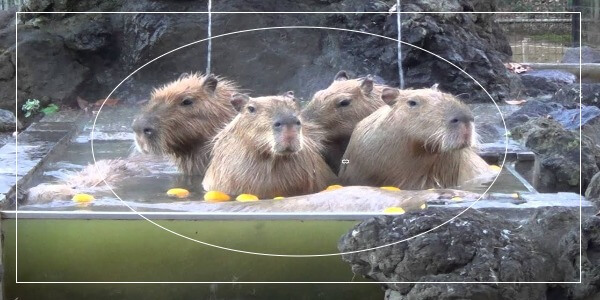You thought that rodents are the smallest and tiniest of all animals, right? Well, you may be wrong. There is a rodent that is as big as a Labrador retriever and that’s the capybara.
There are two common capybara species but the Hydrochoerus hydrochaeris is the largest rodent in the world as of now. This rodent borrows some similar physical attributes of a Labrador dog, guinea pig, beaver, and an actual pig. A full-grown capybara can weigh up to 150 pounds, which is bigger than the size of some dogs and cats.
The capybara comes from the jungles of South America and they are found in grasslands and forests with swamps, marshes, and rivers. They are herbivorous animals, they feed on grasses, water plants, and fruits.
Capybaras are interesting animals, they are popular in Venezuela, Brazil, Columbia, and other South American countries. Though born and raised in the wild, they are surprisingly friendly and gentle. This article uncovers more facts about these fascinating rodents.
What Are Capybaras?

Capybaras are large rodents from South America but can be found in several countries. They live in tropical rainforests and enjoy spending their time in water swimming and playing with themselves.
Capybaras are called water hogs or water pigs due to their affinity for water bodies. They love being in the water and can spend the whole day playing, bathing, and eating grasses in the water. Also, rivers, ponds, and other water bodies serve as a place of refuge for them against predators such as jaguars and harpy eagles.
The capybara is closely related to guinea pigs and rock cavies. They belong to Caviidae, which is the same cavy family of guinea pigs. Although they look similar to guinea pigs and other rodents, they are different and larger.
The capybara isn’t the largest rodent to have existed but the giant pacarana (Josephoartigasia monesi), which lived between 2 to 4 million years ago. They weighed over a ton and measured around 10 feet (3 meters).
With the extinction of the Josephoartigasia monesi, the capybara has the title of the “world’s biggest rodent.” They weigh around 77 to 145 pounds (33 to 66kg) and some weigh up to 150 pounds.
On average, capybaras have a body length of 2 to 3 feet. They have an enormous size that can be likened to a Labrador retriever.
How Big Are Rodents?
With more than 2,000 rodent species on Earth, it is safe to say rodents are one of the most common mammal groups in every part of the world, except Antarctica. Rodents exist in almost every corner and part of the earth, including desert lands, urban and rural areas, and places with cold and hot temperatures.
Rodents are grouped in the order Rodentia, a Latin word meaning “to gnaw.” All rodents, including capybaras and guinea pigs, share a common trait – they have a pair of incisors in their lower and upper jaws that never stop growing. In other words, their teeth continuously grow throughout their existence.
The Rodentia family consists of a variety of mammals with different sizes, shapes, colors, and appearances. Some of the popular members of this family are guinea pigs, squirrels, gerbils, rats, and mice. You may have heard about some of the aforementioned names but there are hundreds of names you probably don’t know about.
Mice, for instance, are the most common rodents in the world. They can be found in and outside the home. While mice are the smallest rodents in the world, the capybara is the largest rodent on Earth. The house mouse (Mus musculus) has a tail that measures over two to four inches long and this rodent can grow up to 3 to 4 inches long.
What is The Biggest Rodent In The World?
Capybara are the world’s biggest rodents. All the way from birth to adulthood, these rodents have a large size.
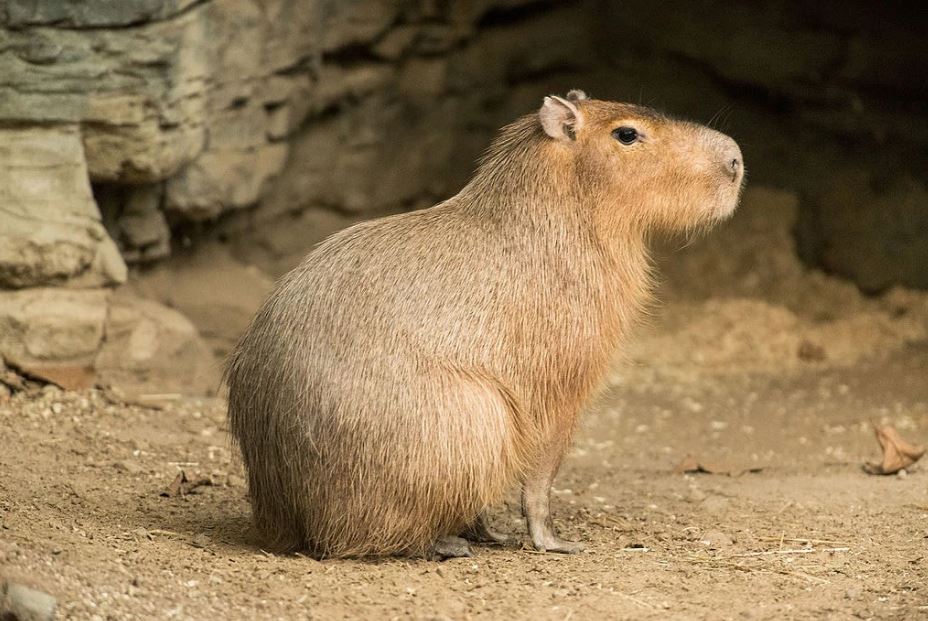
On average, a capybara can weigh between 65 to 150 pounds. Full-grown adult capybaras tend to grow up to four feet from nose to tail area. When standing, they can reach up to 2 and a half feet tall at shoulder level.
The capybara comes from the Caviidae family, which also includes other rodents such as chinchillas, agoutis, and guinea pigs. As mentioned in the introductory section of this article, there are two common species of the capybara.
While the Hydrochoerus hydrochaeris is the largest and most popular capybara on the planet, there exists a smaller capybara. The lesser capybara known as Hydrochoerus isthmius weighs between 62 to 100 pounds.
They are not as large as the other capybara. The lesser capybara is the 3rd largest rodent in the world. It ranks behind the North American beaver, which weighs around 110 pounds on average.
The capybara isn’t the largest rodent in history. The largest rodent to ever surface on the planet was the giant pacarana (Josephoartigasia monesi), which lived millions of years ago.
The skull of a giant pacarana measures between one and three-quarters ft. long and the size is similar to the size of a beef cow skull. Studies suggest that this rodent weighed over 1,000 pounds.
What Do Capybaras Look Like?
Capybaras can be distinguished from other rodents – thanks to their appearance. Capybaras have short, brown-reddish fur. They have square heads and stout bodies, their nose, ears, and eyes are found at the top region of their head. They also have a set of short, webbed feet that help them run and swim.
Capybaras have small ears and tails. Their stout legs and webbed toes help them swim and move themselves in water quickly. They are called semi-aquatic animals because they spend a lot of time in water. Capybaras can stay in water and hold their breath underwater for over 5 minutes.
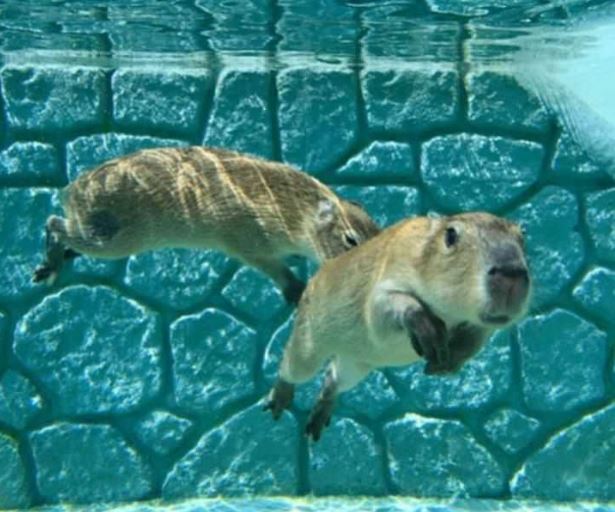
They can be found along riverbanks and streams taking a nap, playing, bathing, or grazing on water plants. The capybara is a gluttonous animal and can consume over six to eight pounds of grass in a day. They are found in swamps, marshes, lakes, streams, ponds, and rivers feasting on all manner of grasses and aquatic plants.
It is easier to distinguish the larger capybara from its lesser counterpart because of their size. Apart from that, there are other differences that can be used to tell one species from the other. In terms of color and overall appearance, the lesser capybara has a more brownish fur than the larger capybara. Also, the fur of the lesser capybara may contain white or yellow patches on it.
Another difference between the larger capybara and the lesser capybara is that the former has hairless noses while the latter has hairy noses. From their appearance and physical attributes, the lesser capybara appears more like a giant guinea pig.
While capybara resembles a guinea pig, it is important to understand their dietary needs and requirements, so both animals should be treated differently.

Why Do Capybaras Like Water?
Although capybara are not like swine, they are endeared to water. The larger capybara loves water and would stay in any area with access to water bodies.
A lot of studies have been performed to know why the capybara loves water. The capybara’s genus and scientific name are coined from Greek, which means “water pig.”
Capybaras are semi-aquatic in nature, so they can stay on land and in the water. However, they do not live in the water. Capybaras have dry skin, making it imperative for them to stay in the water. So, they stay in water to keep themselves hydrated and regulate their body temperature.
A capybara in captivity can get sick or die if it is not provided with a pool. In the wild, these rodents tend to spend time in lakes, rivers, swamps, ponds, and streams, bathing or chilling in water. They have a special attraction for the water.
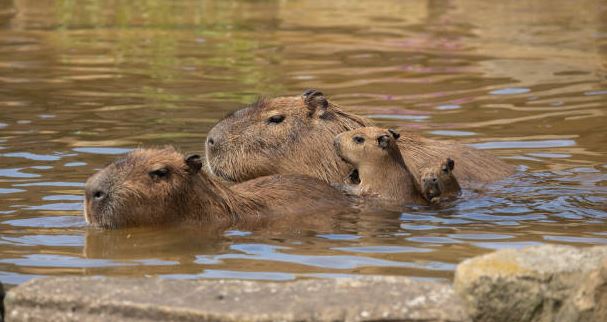
The capybara can poop in water and even mate in water. Capybara live in groups made up of males and females and they get to socialize for friendship and matchmaking purposes. If a female capybara gets underwater or leaves the pond, it shows she isn’t interested in the male capybara or mating with him.
Capybaras can stay underwater for over five minutes. They typically do this in search of food under the water or to evade predators like jaguars. Staying underwater keeps them away from the sight of predators while giving them a view of what is going on above the water’s surface.
Their nostrils, ears, and eyes are situated on the top of their head, making it easy for them to submerge themselves underwater and take peaks occasionally to know if they are safe or under attack. They can press their ears against their head. Doing this prevents water from going inside their ears.
What Do Capybaras Eat?
Capybaras are herbivores, their diet consists mainly of grasses and water plants. While they feed on grasses, they are picky about what they consume and don’t eat all plant species in the wild.
Capybaras have their favorite food – aquatic plants, which is plenty during the wet season. But when they can’t find their favorite meal in the dry season, they would eat any available grass.
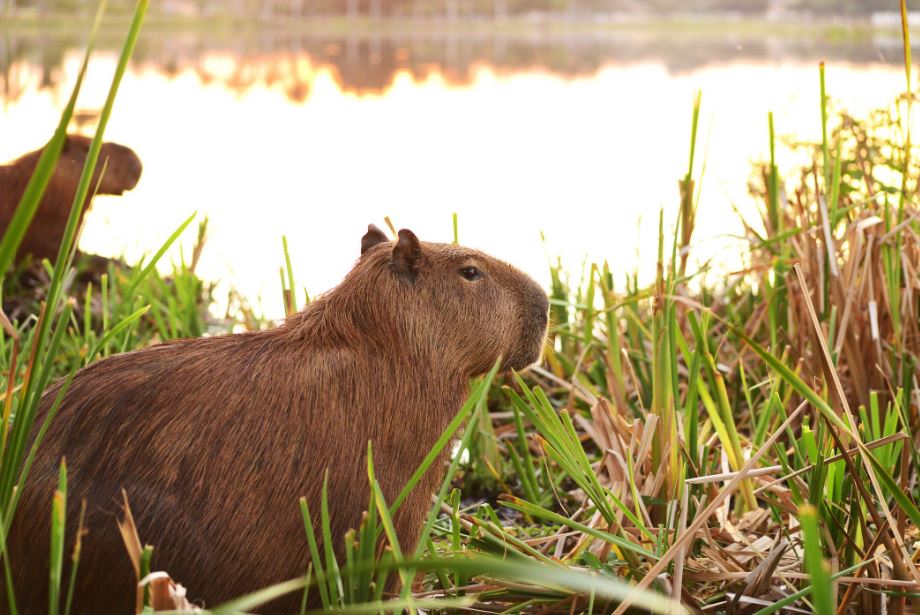
Capybaras are also coprophagous, meaning they feed on their feces. Eating their poop helps them digest their meals properly and get the nutrients from the meal in full. It can also help them get good bacteria that will be helpful in their body system.
Although capybara are not related to cows and goats in any way, they follow their pattern of regurgitating their food. Capybaras have a set of teeth that grow throughout their lifetime. While humans chew their meals up and down, capybaras chew from side to side.
Chewing grasses help their dentition and aid in the digestion of their meals. On average, an adult capybara can eat over 6 to 8 pounds of grasses daily, which is over 3 to 4 kilograms.
What Eats The Capybara?
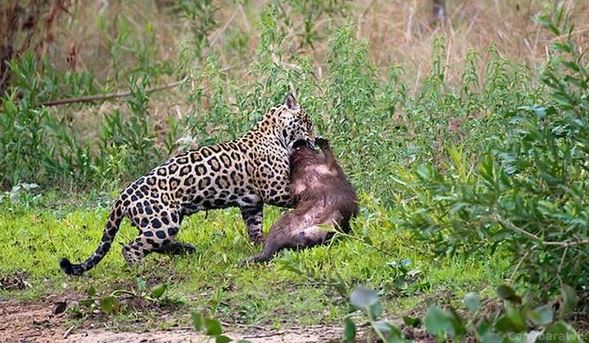
Capybaras are sumptuous meals for caimans, anacondas, ocelots, jaguars, eagles, and puma. These predators hunt capybaras and their young ones in the wild, and this is why most capybaras don’t live up to their life expectancy of ten years.
The biggest and most dangerous capybara predator are caimans because they are large enough to take down the capybara, and their powerful jaws are sharp and cut deep into the rodent’s flesh.
How Smart is The Capybara?
Capybaras are intelligent animals. They have a strong sense of smell and their ears are sensitive enough to pick up the movements of predators stalking them.
Capybaras play smart by living in groups made up of 10 to 20 other capybaras. The group tends to grow bigger during the dry season. Solitary capybaras are vulnerable in the wild and can be easily attacked.
Capybaras are social animals, they form groups for mating, reproduction, and self-defense. The group, also known as a herd, consists of superior males who defend all members while the females tend to nurse each other’s young.
Female capybaras give birth twice a year and on average, each mother can give birth to four babies at once. A female capybara can nurse and feed the baby of another female. They typically look out for each other in the wild. Baby capybaras are called pups.
However, capybaras are not as smart as dogs. These rodents can cause serious damage to private property when kept in captivity. They can use their long, ever-growing teeth to chew anything in your house, including your furniture. If you want to keep a pet capybara, spending time with it will prevent or reduce any likelihood of damage.
Should I Keep a Pet Capybara?
If you are considering keeping a pet capybara, that’s a good thing. However, keep in mind that capybaras are wild animals and may not be ideal to keep in a typical home or apartment.
These giant rodents require a lot of space and access to a pool of water. They require a specialized enclosure and diet similar to what they get in the wild.
Most importantly, before buying a pet capybara, it is crucial to check the wildlife regulations and laws in your vicinity to ascertain whether it is legal to keep it. Certain cities and towns require individuals to obtain a permit or license before buying or keeping a capybara.

While capybaras are wild animals, they are trainable. These rodents get to learn quicker when taught. So if you will be having a capybara, be sure to spend a lot of time with it and teach it your dos and don’ts.
Capybaras thrive in groups, so you must keep this in mind before purchasing. Capybaras enjoy the company of other capybaras. When purchasing a capybaras, you must consider their dietary needs as well. They eat a lot of grasses on a daily basis, so you must have access to all forms of vegetation and fruits.
While capybaras are legal to be kept as pets in certain parts of the United States, it is a common pet in South America. People in several Venezuelan cities and villages farm and breed capybara for meat and hide. Also, capybara meat is a sweet delicacy in many parts of South America.
Frequently Asked Questions
Are Capybaras Rodents?
Capybaras are rodents. Their size makes them unusual and different from other rodents. The capybara are large and grow as big as 150 pounds. There are two common capybara species, and they are both rodents.
What Do Capybaras Eat?
Capybaras eat grasses, tree bark, fruits, and water plants. From their habitat in South America, these rodents stay close to water bodies where they can easily find their favorite food – aquatic plants.
Capybaras are not the only grass-eating rodent species on the planet. Guinea pigs also eat grass hay and vegetables.
Do Capybaras Eat Their Own Poop?
Capybaras often eat their poop to extract and absorb the nutrients that weren’t absorbed the first time the meal was eaten.
How Well Do Capybaras Adapt In Wet and Dry Seasons?
Capybaras get to adapt to different seasons. They enjoy the wet season because they tend to find their favorite foods and other nutritious vegetation without struggles. Their intestines contract during this season and they typically find water bodies to chill and relax in.
On the other hand, their small intestine grows bigger in the dry season, which ensures the absorption of more nutrients. Their food is less nutritious during this season but they eat the plants and vegetation they can find.
Do Capybaras Live On Land or In Water?
Capybaras are often referred to as “semi-aquatic,” meaning they can live partly in water and on land. They do not really live inside the water but spend a lot of time in the water.
Their webbed feet help them swim as fast as they want. Also, they have membranes between their toes which gives them quick mobility in water.
Their nostrils, eyes, and ears are located on the top of their head, so they can stay submerged underwater as long as they want. They have taken advantage of this ability to evade jaguars and other threatening predators.
Capybaras are versatile enough to stay in water and on land. Doing this helps them source water plants and relax in water. Capybaras can take a nap and sleep off while in water.
What Are Threats To Capybaras Existence?
Capybaras are faced with several challenges threatening their existence. Their natural habitat and home in the wild is being destroyed by humans. Also, capybaras are hunted and poached by humans for their meat and hides.
The life expectancy of a capybara is between eight to twelve years but sadly, most capybaras, don’t get to live up to five years. Only capybaras that are well taken care of in captivity get to live more.
Capybaras in the wild are attacked by several predators, including ocelots, caimans, harpy eagles, jaguars, etc. This article provides more insights on capybara predators. While capybaras are not endangered, it is important to preserve their population.
Conclusion
Capybaras are rodents, they are the largest rodent species on the planet. These giant rodents are unusual pets in most homes. Their diet consists mostly of grasses, water plants, tree bark, fruits, and vegetation.

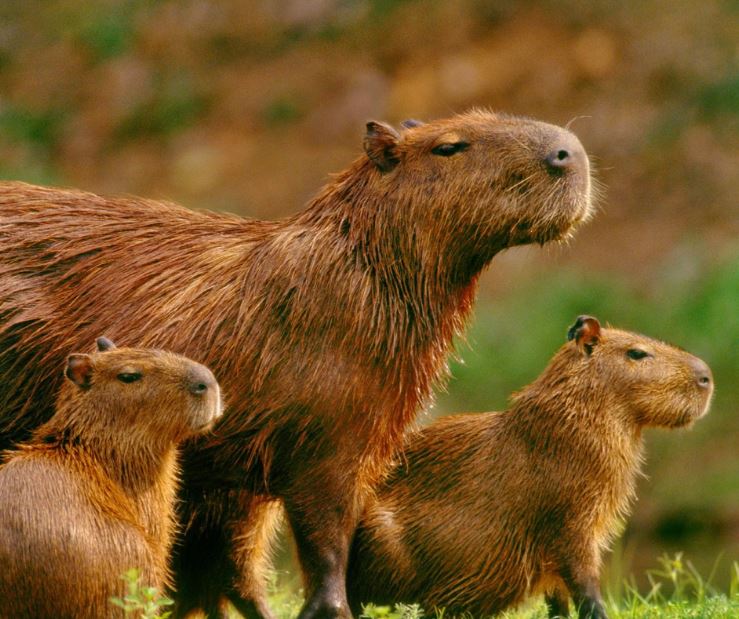
![Capybara Meat And Its Culinary Uses - [Every You Should Know] Capybara Meat & Culinary Uses](https://capybaratips.com/wp-content/uploads/2023/03/Capybara-meat-250x200.webp)
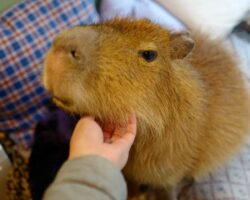
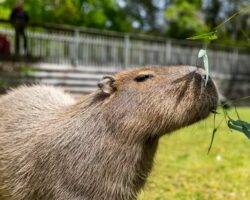
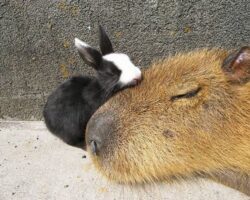
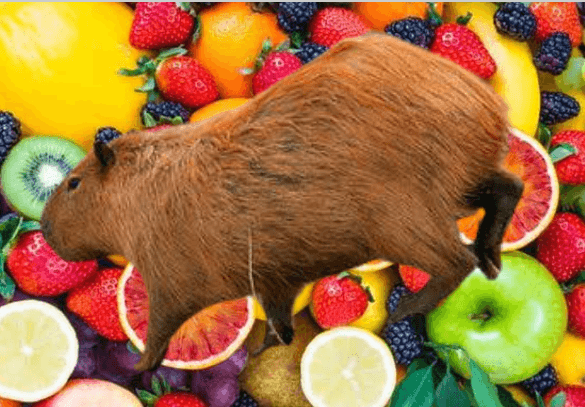
![How Big Should a Capybara Enclosure Be? - [Sizes & Design] How Big Should a Capybara Enclosure Be](https://capybaratips.com/wp-content/uploads/2023/03/Capy-Enclosure-250x200.webp)
